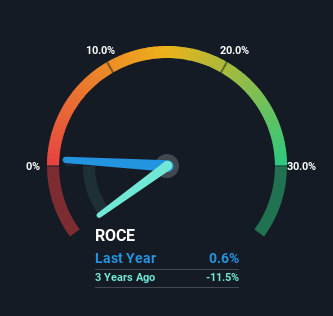- United States
- /
- Hospitality
- /
- NasdaqGS:SABR
Returns On Capital Signal Difficult Times Ahead For Sabre (NASDAQ:SABR)
When we're researching a company, it's sometimes hard to find the warning signs, but there are some financial metrics that can help spot trouble early. Typically, we'll see the trend of both return on capital employed (ROCE) declining and this usually coincides with a decreasing amount of capital employed. This combination can tell you that not only is the company investing less, it's earning less on what it does invest. On that note, looking into Sabre (NASDAQ:SABR), we weren't too upbeat about how things were going.
Return On Capital Employed (ROCE): What Is It?
If you haven't worked with ROCE before, it measures the 'return' (pre-tax profit) a company generates from capital employed in its business. Analysts use this formula to calculate it for Sabre:
Return on Capital Employed = Earnings Before Interest and Tax (EBIT) ÷ (Total Assets - Current Liabilities)
0.0058 = US$22m ÷ (US$4.7b - US$908m) (Based on the trailing twelve months to September 2023).
Therefore, Sabre has an ROCE of 0.6%. In absolute terms, that's a low return and it also under-performs the Hospitality industry average of 9.1%.
Check out our latest analysis for Sabre

Above you can see how the current ROCE for Sabre compares to its prior returns on capital, but there's only so much you can tell from the past. If you're interested, you can view the analysts predictions in our free report on analyst forecasts for the company.
What Can We Tell From Sabre's ROCE Trend?
The trend of returns that Sabre is generating are raising some concerns. The company used to generate 12% on its capital five years ago but it has since fallen noticeably. In addition to that, Sabre is now employing 20% less capital than it was five years ago. The combination of lower ROCE and less capital employed can indicate that a business is likely to be facing some competitive headwinds or seeing an erosion to its moat. If these underlying trends continue, we wouldn't be too optimistic going forward.
The Key Takeaway
To see Sabre reducing the capital employed in the business in tandem with diminishing returns, is concerning. This could explain why the stock has sunk a total of 81% in the last five years. Unless there is a shift to a more positive trajectory in these metrics, we would look elsewhere.
One more thing: We've identified 3 warning signs with Sabre (at least 1 which is a bit unpleasant) , and understanding them would certainly be useful.
While Sabre may not currently earn the highest returns, we've compiled a list of companies that currently earn more than 25% return on equity. Check out this free list here.
New: Manage All Your Stock Portfolios in One Place
We've created the ultimate portfolio companion for stock investors, and it's free.
• Connect an unlimited number of Portfolios and see your total in one currency
• Be alerted to new Warning Signs or Risks via email or mobile
• Track the Fair Value of your stocks
Have feedback on this article? Concerned about the content? Get in touch with us directly. Alternatively, email editorial-team (at) simplywallst.com.
This article by Simply Wall St is general in nature. We provide commentary based on historical data and analyst forecasts only using an unbiased methodology and our articles are not intended to be financial advice. It does not constitute a recommendation to buy or sell any stock, and does not take account of your objectives, or your financial situation. We aim to bring you long-term focused analysis driven by fundamental data. Note that our analysis may not factor in the latest price-sensitive company announcements or qualitative material. Simply Wall St has no position in any stocks mentioned.
About NasdaqGS:SABR
Sabre
Operates as a software and technology company for travel industry in the United States, Europe, Asia-Pacific, and internationally.
Undervalued with moderate growth potential.
Similar Companies
Market Insights
Community Narratives



